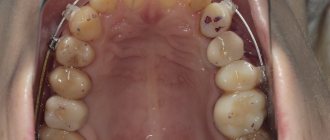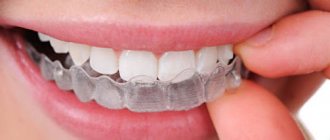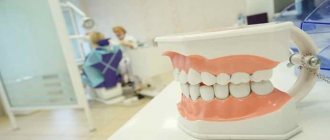Bite defects are not as rare a problem as it might seem. Medical statistics show that every third person has malocclusion in one form or another! If the anomaly is serious and noticeable, it is corrected in adolescence, but people are in no hurry to deal with mild crooked teeth. And most often because they don’t want to wear braces that others can easily see.
But modern dentistry is ready to offer patients an alternative to braces - these are transparent aligners, wearing which can help correct the bite and acquire a beautiful smile. At the same time, your treatment will remain invisible to strangers and will not cause you any discomfort!
In the article we will talk in detail about how bite defects are treated with mouth guards, what are its features, what types of mouth guards exist and how long they will have to be worn in order to straighten the teeth and acquire an attractive smile.
What are orthodontic aligners, indications for use
The aligners also have a second name - aligners. At their core, they are soft and transparent overlays for teeth, which are made from hypoallergenic polymer materials. Mouthguards, unlike braces, are removable structures: you can put them on and take them off yourself, without visiting the orthodontist’s office.
The mechanism of the beneficial action of mouth guards for correcting occlusion is as follows: the design completely covers the jaw arch and creates pressure on the areas of the dentition that need correction. The main advantage of orthodontic aligners is convenience. Wearing them does not cause any discomfort, adaptation to them is quick, and when correcting a bite with mouth guards, there is no need to follow a diet that excludes any food products.
When can mouth guards be used to correct a bite? Indications for the use of orthodontic aligners are as follows:
- The presence of noticeable interdental spaces;
- Slight displacement of individual teeth in a row;
- Slight crowding of teeth;
- Poor open, cross or distal bite.
IMPORTANT: Unfortunately, serious malocclusion cannot be corrected with mouthguards. To correct significant pathologies, braces are used, most often metal ones, which can create strong pressure on the teeth and thereby bring them into the correct position.
Take a short test and calculate the cost of treatment!
Take a short test
- Jaw selection
- Availability of photo
- Selecting a brace system
- Date of treatment
- Cost calculation
×
Manukyan Artavazd Genrikovich
Chief physician of the clinic
In what cases is effectiveness demonstrated?
Despite all the positive qualities and advantages of aligners, they are not omnipotent. Mouth guards are indicated for use for leveling minor bite pathologies, or as a supportive means after removing the braces.
For advanced deformities or serious disorders, they are ineffective.
This is why the decision about the choice of treatment method should always be made by the orthodontist. Only he can determine the advisability of installing mouth guards and predict the result of the correction.
For more accurate diagnosis and choice of methodology, 3D computer modeling should be used; this will minimize the likelihood of error and allow you to create the most effective design.
How is a bite corrected using mouthguards?
Correcting a bite with mouth guards begins with a visit to the orthodontist's office. During the first appointment, the doctor examines the oral cavity, assesses the correctness of the bite, and additional diagnostic measures may be prescribed - for example, a panoramic photograph of the jaw. A detailed diagnosis before starting orthodontic treatment and bite correction will help the orthodontist choose the most effective correction method for a specific clinical case.
If the diagnosis shows that in your case it is possible to correct the bite with mouthguards, then further treatment will proceed according to the following scheme:
1. Professional oral hygiene will be carried out, necessary for high-quality cleaning of teeth from plaque and tartar.
2. Impressions are taken of the teeth, on the basis of which a plaster model of the patient’s jaws is made.
3. Mouthguards are created using the finished plaster model. Aligners are made not as a single copy, but as a whole set. You will change mouthguards to correct your bite according to the scheme that the orthodontist will develop for you. Changing the aligners is required to create the correct pressure on the teeth, which will promote their displacement and alignment.
IMPORTANT: The effectiveness of correcting your bite with mouthguards will largely depend on your attitude towards treatment. Mouthguards must be worn for at least 20-22 hours. If you break this rule, you may not expect a positive result from bite correction!
Diet
There is no need to change your diet after installing the mouthguard, since the plate is removed before eating. With braces you will have to stick to a diet. In the first days after fixing the braces, as well as after tightening the arches, you can only eat liquid food. Subsequently, you need to give up solid foods: hard meat, nuts, apples, carrots, etc. They should be ground or ground before eating. It is also necessary to limit the consumption of sweets, sticky foods and drinks with coloring substances: soda, coffee and tea.
After installing braces, it is important not only to exclude certain foods from the diet, it is also recommended to observe the temperature regime. You should not eat food that is too cold or too hot. It negatively affects the condition of the structure and enamel.
Many people mistakenly believe that braces damage teeth, since a large number of bacteria accumulate under them. However, germs can only appear under the arc, and if you take care of hygiene, they will not cause any harm. The locks themselves are sealed tightly, so neither microorganisms nor food debris can get under them. The part of the tooth to which the lock is glued, on the contrary, is reliably protected from external influences.
How many trays may be needed to correct a bite?
How many trays are included in the bite correction kit? The answer to this question will depend on two main factors:
- Difficulties in malocclusion that needs to be corrected;
- Patient's age. The older a person is, the longer orthodontic treatment can be, because after the final formation of the dental system, tooth displacement occurs more slowly. That’s why dentists recommend correcting your bite in childhood and adolescence!
Thus, a full course may require about 15-40 pairs of mouth guards, and each mouth guard will have its own shape and size. To correct the bite, the mouthguards are changed every 2-3 weeks.
Regular change of aligners when correcting a bite is necessary: it allows you to achieve the tightest possible fit of the structure to the teeth. Due to the high density of the mouth guards, they will exert pressure on the teeth, which will cause the teeth to shift in the desired direction. As soon as the pressure becomes insignificant, the used mouth guards are replaced with a new pair.
Mouth guards as an alternative to braces
Straightening crooked teeth, of course, should be done in childhood. However, many parents simply do not pay attention to this problem. Therefore, the question of orthodontic treatment for most patients arises in adolescence or adulthood. However, not every teenager or adult will agree to put braces on their teeth and follow not the most simple rules of hygiene. Until recently, there was no alternative to braces. But with the advent of aligners - mouth guards for straightening teeth, it became possible to undergo orthodontic treatment unnoticed by others and with comfort for yourself. Moreover, this applies not only to adults, but also to teenagers, for whom their own technology of transparent mouth guards has been developed. Like aligners for adults, they are a set of removable aligners, completely invisible to others, which can correct most dental anomalies, provided that the attending physician has the appropriate experience.
Types of mouthguards for correcting bite
Orthodontic mouthguards for correcting bites have their own classification. They are divided into different types according to the following characteristics:
— Material of production. Mouthguards for correcting bites can be made of silicone or polyester;
- Production technology. On this basis, standard and individual dental guards are distinguished.
Each type of mouthguard for correcting the bite has its own characteristics, which will be useful for people planning to undergo orthodontic treatment.
Children's orthodontic mouthguard
In addition to adult and orthodontic aligners, children's systems should also be mentioned. All of them are used at a certain age, stimulate the development of a correct bite and correct orthodontic deficiencies.
To train muscles and straighten teeth
Trainers and LM activators are often called teething trays. They are made of silicone and are used to correct primary, mixed and permanent dentition. These products can have different heights and lengths: the optimal parameters are selected in accordance with the specific clinical case.
Customized dental guards
This is the best option for correcting malocclusion, because such mouthguards are made individually for each patient and based on impressions of his teeth. This allows you to ensure maximum tightness of fit of the trays to the teeth.
Individual mouth guards for correcting occlusion are made from silicone - a plastic, hypoallergenic and transparent material, so the designs will be comfortable to wear and completely invisible on dental surfaces. One of the most popular options for customized mouth guards for correcting malocclusion is the Invisalign system. But they are not made from silicone, but from a biopolymer and sufficiently rigid material. We will talk in detail about Invisalign mouth guards for correcting bites in a separate section of our article.
Why Invisalign? Brand benefits
Invisalign has gained popularity among dentists around the world and their patients due to its effectiveness and discreet wearing. Main advantages of the brand:
Invisalign aligners for correcting malocclusion
Invisalign aligners are a set of designs, the number of which is determined for each patient individually. The more complex the bite defect that needs to be corrected, the more number of trays will be made for a full course of correction. Unlike other types of aligners, Invisalign aligners can also be used to correct complex malocclusions, such as straight and medial bites.
Invisalign aligners are made to correct the bite using a 3D model of the jaws, which is created by a computer program. The use of computer technology allows not only to obtain anatomically accurate orthodontic structures for effective treatment, but also to show the patient the final result of the correction.
The three-dimensional model and impressions are sent to a laboratory in the USA, where a full set of mouth guards is manufactured to correct the bite. When the kit is ready, the patient is invited to the clinic, where the orthodontist gives detailed advice on wearing the aligners and caring for them.
Invisalign mouth guards are one of the most expensive types of aligners; the total cost of a course of treatment starts at 400,000 rubles. However, these are the most convenient and effective mouth guards to use and, importantly, are invisible on dental surfaces. This quality of Invisalign aligners is especially appreciated by adult patients.
You can get detailed advice on Invisalign aligners and their use in bite correction at our premium dentistry clinic in Moscow - “Aesthetica”. Making an appointment with our dental specialists is very simple: you can do this through a special form on the website or by dialing our contact phone number. "Aesthetica" - advanced technologies for the health of your teeth and the beauty of your smile!
What is more effective
The task of mouthguards and braces is the same - to correct the bite and straighten the teeth. Aligners became known only 20 years ago, but are already very popular among doctors and patients. These designs are chosen as often as braces. An aligner is a plate that is placed over your teeth. It is impossible to say exactly which brand of mouth guards is best. Treatment with all models of structures gives excellent results. The only difference is the price. Correction with aligners is comfortable and painless.
Sign up for free 3D modeling of your future smile!
Make an appointment
*By making an appointment you consent to the processing of your data
It only takes a few days to adapt. A significant advantage of aligners is invisibility. If you want to hide the use of a corrective structure, choose mouth guards. A lingual brace system, which is attached to the inside of the teeth, is also suitable.
When wearing metal systems, the treatment will last a little less. They do not change color, are durable and comfortable. The only disadvantage of metal braces is that they cannot be hidden from the eyes of others. But there is a way out. In this case, ceramic or sapphire models are suitable for you. When a patient comes to the Propricus clinic, the orthodontist offers him several correction options. The doctor talks about the features of each method, all the pros and cons. Our task is to help make an informed choice, a method of bite alignment that suits the patient’s priorities and capabilities.
Advantages and disadvantages of using mouth guards to correct bites
Mouthguards for correcting bites have a number of advantages that make orthodontic treatment comfortable and convenient for patients:
— Mouthguards are removable structures, and this provides a number of advantages. Firstly, the mouth guard can be easily removed before an important meeting or special event, and secondly, this allows for high-quality oral hygiene and comfortable eating. You simply remove the mouth guard while eating for quality cleansing;
— The process of adaptation to mouth guards for correcting malocclusion proceeds quite quickly. In just 2-3 days you will stop noticing the aligners on your teeth;
— Wearing aligners does not cause problems with diction and does not interfere with active communication;
— The elastic material of the mouth guard does not injure the soft tissues of the oral cavity, does not cause allergic reactions and does not have a negative effect on tooth enamel;
— Mouthguards for correcting bites are made from transparent materials and therefore they are invisible on the teeth;
— The structures are easily cleaned from food debris and plaque;
— Correcting your bite with mouth guards can be combined with teeth whitening: to do this, just apply a special whitening gel to the inner surface of the product.
Treatment of bite defects with mouthguards is possible at any age and has fewer indications than therapy using traditional braces. But in addition to the advantages, mouth guards for correcting bites also have some disadvantages that are important to consider before starting treatment.
Among them:
— Mouthguards cannot correct serious malocclusions;
— It will take a long time to produce a full set of mouth guards to correct your bite.
It is worth noting that the price of correcting a bite with aligners may be more expensive than treatment with braces.
Recommendations
Wearing mouth guards requires compliance with several rules that help speed up treatment and keep the products in their original condition.
Recommendations from orthopedists for the use of mouth guards:
- should not be washed in hot water or subjected to other high-temperature treatment methods;
- It is not advisable to take hot food or drinks;
- oral hygiene is carried out using a standard method, and correctors are cleaned with a regular, but separate brush using regular toothpaste;
- Cleaning of products is carried out 2-3 times a day (at night - before bedtime);
- Do not clean the mouth guards; they must be removed;
- For cleaning, you can also use a special disinfecting pad or solutions;
- for ease of storage, it is advisable to use a special case;
Before installing the trays for the first time, the specialist explains all the features of their use and care.
Rules for wearing and caring for mouth guards to correct your bite
There is nothing complicated about caring for mouth guards to correct your bite. All you need to do is:
1. Remove the mouth guards from your mouth while eating and each time after removal, rinse them in clean, cool water. 2. After removing the aligners and before putting the aligners back on, carefully and efficiently brush your teeth to remove plaque and food debris. In this procedure, it is recommended to use not only a brush and toothpaste, but also dental floss and rinses. 3. The outer surface of the trays to correct the bite should be cleaned with a soft brush and paste. 4. Aligners should be stored in a special container. 5. If you accidentally damage the mouthguard, it should be replaced with a new pair. 6. Mouthguards cannot be bent, washed with aggressive substances or just hot water.
And of course, don’t forget that mouth guards only work to correct your bite if you wear them regularly and at least 20 hours a day.
Installation for children and adults
Braces can be installed on molars at almost any age. The dental system in humans is formed until approximately 17-18 years of age, and the final bite is formed by 12-14 years of age. It is best to get braces during adolescence, as children's dental tissues are more pliable. Staples are also effective in treating adults, but preparation for their installation will require more time and effort. In addition, the healing process will be longer.
Trainers can also be prescribed to both young patients, even those with baby teeth, and older ones. However, it is worth considering that mouth guards are a removable device. If an adult can control himself, then the child will have to be constantly monitored so that he does not remove the aligners if discomfort occurs.
Typically, plates are used when the child’s molars are just erupting, if there is a risk of their improper growth. After the bite is formed, it is better to install braces. As for adults, their choice is determined primarily by indications, and only then by their own preferences.
Duration and effectiveness of treatment with mouthguards for correcting malocclusion
The timing of treatment will depend primarily on the complexity of the malocclusion that needs to be corrected. The average duration of aligner therapy in adult patients is 1 year. This is taking into account your disciplined approach to treatment! The orthodontist will definitely calculate the approximate time frame for the general course of correction when drawing up a treatment plan!
Mouthguards for correcting bites are effective in correcting mild anomalies; if you need to eliminate severe crowding of teeth or serious pathology, it is optimal to plan treatment using classic braces.
Silicone aligners for teeth straightening
Treatment with clear aligners minimizes the risk of medical error. The fact is that while wearing braces, the dentist takes a very active part and is independently involved in their installation and corrections, and in the process he may make a mistake. As a result, the course of treatment and, as a consequence, its outcome may be disrupted. In addition, during the next correction, there is a risk of “tightening” the ligature, which can cause severe pain and “eversion” of the roots of the teeth. A transparent mouthguard for straightening teeth for adults acts on hard tissues very smoothly and, if the doctor initially correctly calculated the trajectory of teeth movement, cannot disrupt the course of treatment.
Price for mouthguards to correct bite
The total cost of a course of bite correction with aligners will depend on the length of treatment and the number of aligners that will need to be made. In addition to the price of the aligners themselves, it is worth considering additional procedures that may need to be performed before starting orthodontic treatment. Thus, mouthguards should not be worn if you have caries, gum disease, or poor oral hygiene. Diagnostics, photographs and casts of the jaw are paid separately. Therefore, the exact cost of a course of treatment with mouth guards to correct your bite can only be calculated for you in the orthodontist’s office.
If you are thinking about correcting your bite, come to our clinic in Moscow - “Aesthetica”! Our experienced orthodontists will definitely select the treatment method that will be most effective in your case! We offer our patients the best technologies, materials, individual approach and guarantee that with us you can treat your teeth and get a beautiful smile in a comfortable environment and without pain!
General overview
The term “mouth guard” is quite common and is familiar to every athlete or fan who is interested in contact sports or martial arts. A silicone or polymer onlay, made according to a standard template, or based on casts from the jaw, completely covers the dentition, tightly adhering to the enamel, and eliminating displacement or discomfort.
Today, in order to buy a night guard for teeth in St. Petersburg, it is enough to place an order at any large pharmacy. However, it is worth considering that such products do not take into account the peculiarities of the anatomy of the dentofacial apparatus, and therefore can only be used as a protective pad, effective for diagnosed bruxism. To achieve a therapeutic result, expressed in the alleviation of negative symptoms, it is recommended to contact the clinic and order the production of a custom mouth guard.
How to wear mouth guards after braces without damaging them?
Mouthguards are made of plastic material, so they can be easily damaged if handled carelessly. In this case, the device will no longer perform its main task - to hold the teeth in the correct position. If it breaks, it cannot be repaired; a new one will have to be made. Therefore, it is important to follow the rules of safe operation.
How to wear a mouthguard correctly:
- To avoid damage, it must be removed before each meal.
- Plastic aligners do not withstand high temperatures well, so you should not drink hot tea, coffee or other drinks with an orthodontic structure in your mouth.
- Between uses, the mouthguards are worn like other personal care products - in special lockable containers. This protects the device from contamination and damage.
- You cannot smoke with a mouth guard in your mouth, because tobacco smoke and tar change the color and structure of the material. The mouth guard becomes cloudy and less flexible.
- The structure is stored at room temperature. Both heat and cold negatively affect its characteristics.
Reviews
Alexander
28.03.2019
I went to Natalya Sergeevna Ivanova for treatment and have been undergoing it for more than a year and a half. I am very pleased with the doctor, her attentiveness and leisurely manner. Always remembers all the nuances. Always greets you with a smile, which is rare these days. The treatment is carried out efficiently using modern equipment quickly, conveniently and comfortably. I always receive SMS messages about a future visit and they always welcome me here with pleasure. Thank you!
Read more
00:38Watch video review
Evgeniya
27.03.2019
I want to say a huge thank you to the PROPRICUS clinic, as well as to the doctors of this wonderful clinic. My acquaintance began with orthodontists. Previously, I didn’t even know that such doctors existed, but after I met Nana Karenovna and Natalya Sergeevna, I realized that the impossible can be possible. Despite the fact that all my adult life I had crooked teeth and I didn’t really want to get braces, which don’t look very aesthetically pleasing, Nana Karenovna explained to me that there are such magical things as Invisalign aligners. And now, after two years, my smile has become beautiful, and now I can smile without embarrassment.
Read more
00:57Watch video review
Natalia
13.03.2019
I have been receiving treatment at the PROPRICUS clinic for a long time. I thought that my case was completely hopeless and since childhood I have suffered and been tormented by the fact that I have crooked teeth. And it was just terrible. By chance, I came across Nana Karenovna on Instagram and initially I came to her for treatment when the PROPRICUS clinic did not yet exist. First of all, I liked her, and when you like a doctor, you are ready, of course, to trust him. My treatment to correct my bite lasted a little over two years. After my bite returned to normal, I needed to have aesthetics done. And the PROPRICUS clinic, represented by the wonderful orthopedist Nikolai Ivanovich Lavrenenko, also came to my aid. He made veneers on my front teeth and ceramic inlays on my old fillings. And now I still need to get an implant on one tooth and of course I will continue treatment at my favorite PROPRICUS clinic. Many thanks to the clinic and all my doctors. You are true professionals in your field. And if my friends or acquaintances need to do something, I will only recommend your clinic to them. Thanks a lot!
Read more
01:34Watch video review
Why is bruxism dangerous?
Bruxism is uncontrollable grinding or clenching of teeth due to spasms in the chewing muscles. This is a fairly common phenomenon, but not all patients realize that the disease poses serious problems:
- pathological abrasion of tooth enamel;
- loss of fillings, crowns;
- dysfunction of the temporomandibular joint (clicking, pain when opening/closing the mouth);
- chronic insomnia and fatigue;
- headaches, dizziness.
Teeth grinding is mainly characteristic of the night, when a person is sleeping and does not control the movements of the jaw. However, in many patients the problem also manifests itself during the day - they involuntarily clench their teeth under stress or when concentrating.











